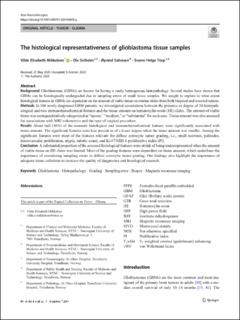| dc.description.abstract | Background
Glioblastomas (GBMs) are known for having a vastly heterogenous histopathology. Several studies have shown that GBMs can be histologically undergraded due to sampling errors of small tissue samples. We sought to explore to what extent histological features in GBMs are dependent on the amount of viable tissue on routine slides from both biopsied and resected tumors.
Methods
In 106 newly diagnosed GBM patients, we investigated associations between the presence or degree of 24 histopathological and two immunohistochemical features and the tissue amount on hematoxylin-eosin (HE) slides. The amount of viable tissue was semiquantitatively categorized as “sparse,” “medium,” or “substantial” for each case. Tissue amount was also assessed for associations with MRI volumetrics and the type of surgical procedure.
Results
About half (46%) of the assessed histological and immunohistochemical features were significantly associated with tissue amount. The significant features were less present or of a lesser degree when the tissue amount was smaller. Among the significant features were most of the features relevant for diffuse astrocytic tumor grading, i.e., small necroses, palisades, microvascular proliferation, atypia, mitotic count, and Ki-67/MIB-1 proliferative index (PI).
Conclusion
A substantial proportion of the assessed histological features were at risk of being underrepresented when the amount of viable tissue on HE slides was limited. Most of the grading features were dependent on tissue amount, which underlines the importance of considering sampling errors in diffuse astrocytic tumor grading. Our findings also highlight the importance of adequate tissue collection to increase the quality of diagnostics and histological research. | en_US |

